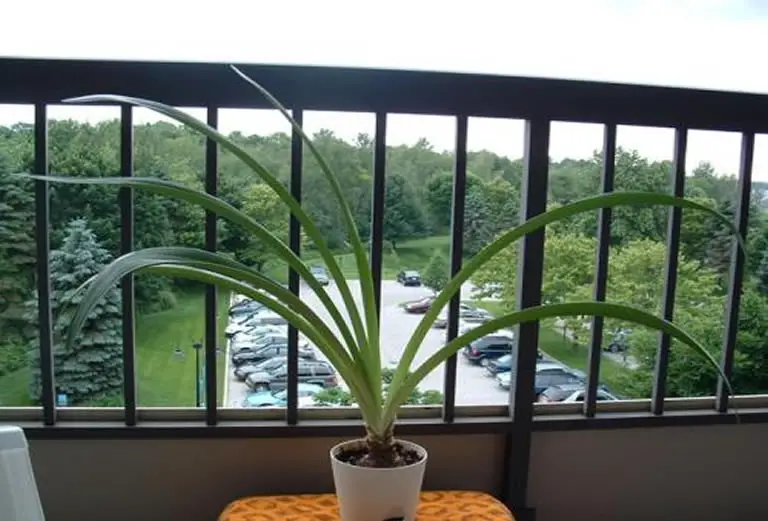Amaryllis is a very popular succulent that is grown indoors all across America. It is an easy-care plant that requires only minimal attention. Unfortunately though a common complaint a come across among amaryllis owners is that their plant will not bloom. In this article I will cover all potential causes for a non-blooming amaryllis and outline each one of the cures.
Table of Contents
Why your amaryllis is not blooming
Amaryllis is an easy-care succulent that usually requires very little attention other than regular watering and fertilization in its growing stage.
However, many owners of indoor potted amaryllis, as well as gardeners who grow amaryllis directly in the yard, worry when their plant produces leaves but no blooms.
Amaryllis are perennials, which means they bloom every year, and a plant that fails to bloom may have one of a number of possible problems.
Luckily, each cause behind the lack of flowering has a very easy fix.
Having said that, if your amaryllis is showing signs of distress, such as discoloring of the leaves or a complete drooping of the plant, there may be more serious causes at play.
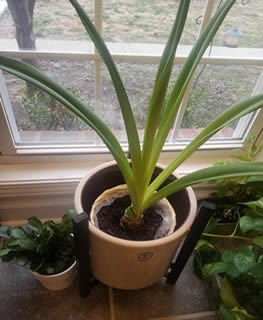
If your plant has healthy leaves that are a lush green and that grow upright then you will find that one of the causes outlined in this article will be to blame for the plant’s lack of blooms.
However, I advise you to read my comprehensive article on amaryllis leaf care if you suspect that your plant is not as healthy as it should be.
For the remainder of this article I will assume that your amaryllis is producing healthy foliage with nice green leaves that stand upright.
If that is the case then one or more of the following causes are most likely behind the lack of blooms on your plant.
Seven reasons why your amaryllis won’t bloom
Below are some of the most common reasons for amaryllis not blooming:
- Insufficient light.
- Immature bulb.
- Overworked bulb.
- Incorrect soil.
- Insufficient nutrients in the soil.
- Incorrect temperatures around the plant.
- It’s not the correct season for flowering.
I will briefly outline how each of the above mentioned points may be the cause behind a non-blooming amaryllis plant and what you can do to fix the situation.
1. The plant is getting insufficient light
One of the biggest causes for a non-blooming amaryllis plant is lack of light.
As a succulent amaryllis has evolved to thrive on light.
Where other plans get much of their growth stimulus from nutrients, water and light, succulents rely mostly on light and photosynthesis to grow.
Amaryllis need 4 – 6 hours of good light per day. Any more than 4 hours of strong direct light can lead to leaf burn in amaryllis though many more hours of indirect light is perfectly fine.
Although amaryllis will grow happily in partial shade and will thrive in indirect light, insufficient light will prevent the plant from blooming.
To understand how amaryllis blooms and how to make it bloom better read this article.
2. You have an immature bulb
Many amaryllis plants will not bloom for the first few years of their life.
An amaryllis bulb often needs time to mature before it produces its striking colorful flowers.
Although many amaryllis bulbs are sold fully matured it is not uncommon to find that you have purchased an immature bulb.
Amaryllis take a few years to reach full maturity. Because this is too long a wait for many people, especially those we grow their amaryllis indoors as a houseplant, these bulbs are usually sold when they have reached maturity.
However, this is not always the case.
You have have purchased a bulb that is not yet old enough to produce flowers.
How do you know if an amaryllis bulb has not yet fully matured?
Amaryllis bulbs are fairly large. Amaryllis bulbs can vary in size but even the smallest will be at least 26/28 cm in size.
A bulb smaller than this is an immature bulb that needs time to grow. So, a small bulb in a strong indication that you have an immature amaryllis.
How do you know what size the bulb is without digging it up?
An amaryllis bulb will have its uppermost part showing above the soil.
It is fairly easy to roughly estimate the overall size of the bulb simply by looking at the peak point sticking out above the soil. It is from this part of the bulb that the leaves grow.
Obviously with a large bulb this area will take up a significant amount of space in the pot while a much smaller bulb will seem dwarfed by the pot.
So what do you do to make an immature amaryllis bloom?
There is nothing you can do to make an immature amaryllis bloom except wait.
The only thing you can do with an immature amaryllis bulb is give it time to mature.
It can take about 3 years before you see your first bloom and even then you may only see one stalk. If you’re lucky you may even get between 1 – 3 flowers.
A way of avoiding this problem in the first place is to buy mature bulbs only.
Be sure to ask the vendor what age the bulbs are before you buy them.
If you grow amaryllis from cutting or from seed then you cannot avoid this situation.
Trust me though, amaryllis are well worth the wait especially if you cultivate several different types with different colored blooms.
It can be especially rewarding if you grow them so they bloom in winter when your other houseplants are resting.
3. The bulb is overworked
An overworked bulb is one of the most common reasons for a non-blooming amaryllis.
There is a lot of talk, especially online, about forcing amaryllis to rebloom.
Although this is totally possible I really don’t recommend it unless you have experience doing this type of thing.
All too often inexperienced plant owners will follow steps given to them for forcing amaryllis to rebloom and all the while they are unknowingly damaging their plants in the process.
There are very specific steps that must be followed to get an amaryllis to rebloom and failure in any one of those steps can damage your plant.
I therefore always recommend that amaryllis owners allow their plant to rest when it reaches its natural dormancy period.
Once an amaryllis has finished blooming and the flowers start to die the bulb will begin to enter a stage of dormancy that lasts about 2 months but can last up to 3 months.
During this rest period the bulb will continue to gather resources in preparation for its new growth cycle.
Amaryllis do not require darkness to go dormant.
However, taking some other “normal” steps may cause the bulb to enter a new growth stage thus preventing it from resting. This will cause later problems with the plant.
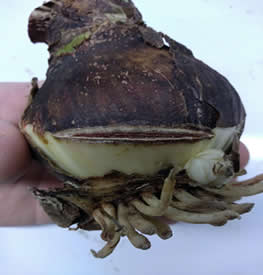
As I already mentioned earlier, it is possible to force an amaryllis to rebloom so it produces flowers more than once per year, but doing this really taxes the resources of the plant.
By forcing it to rebloom you prevent the bulb from not only resting but you also restrict its ability to gather-up enough resources to produce healthy foliage and colorful blooms.
Over time you will end up with a sickly plant and no blooms at all.
If you have been overworking your amaryllis then you must allow the bulb to rest.
In this situation it may be best to move the bulb to a dark or well shaded area for a few months.
Although amaryllis does not require darkness during dormancy it is better to lean on the side of caution with an overworked bulb. So you should place it somewhere where it will not have an opportunity to enter another growth stage.
Darkness will help with this.
Never fertilize the plant when it is entering dormancy as this will reactive the bulb.
Many amaryllis owners who encounter blooming problems have been unwittingly fertilizing their amaryllis when the bulb wants to rest.
Be sure to also follow the appropriate watering routine for an amaryllis.
Although amaryllis require regular watering during growth a resting amaryllis bulb requires much less watering than it does during its growth stage.
As long as the soil is moist (not damp or drenched), when you rest the plant, your amaryllis will not need watering again until new growths start to form. The only exception is if you live in a very warm environment that tends to dry out the soil quicker than normal.
How do you know an amaryllis is entering dormancy when it is not blooming?
Both a blooming and a non-blooming amaryllis will shows signs of entering dormancy through the leaves.
Yellow amaryllis leaves are an indication that the bulb is entering dormancy.
4. The amaryllis is growing in the wrong type of soil
Although amaryllis can be grown in water (though I don’t recommended it) and it will survive in standard succulent soil, if you want a healthy plant with vibrant and abundant blooms you need the correct growing medium.
Unlike many other succulents, that require a gritty soil, amaryllis grows well in a nutrient-rich soil that is usually more appropriate for non-succulent plant types.
Miracle-Gro potting mix has just the right amount of nutrients for amaryllis and this is what I use for amaryllis cultivation from both seed and cuttings. It’s also what I use when repotting the bulb.
5. The soil has insufficient nutrients
Even if your amaryllis is growing in the correct soil it may still be nutrient-deficient.
Amaryllis plants are feeders and so potted plants can quickly strip the soil of nutrients.
Each blooming season it is a good idea to fertilize indoor amaryllis with a feed that has a 10-10-10 ratio of NPK (nitrogen, phosphorus, potassium), like these, as this type of fertilizer will give amaryllis everything it needs to thrive.
Having said that, any one of the good quality slow release succulent fertilizers will work well with amaryllis too.
6. The plant is growing in an area with incorrect temperatures
Amaryllis is a tropical plant, and even variations that are sold in the US as amaryllis but are not strictly speaking amaryllis (instead belong to the Amaryllidaceae family), are subtropical.
These plants therefore need warmth to survive.
Amaryllis does not respond well to low temperatures.
Amaryllis is so sensitive to low temperatures that it can only be kept outdoors all year round in USDA climate zones 9 through 11.
Although it is also often grown outside in climate zone 8 the plant must be brought indoors in this zone when winter approaches. It should only be relocated back outdoors after the early spring frost has passed.
Even indoors amaryllis are susceptible to low temperatures and they should be grown in the correct temperature-window of between 70° and 90°F.
Amaryllis should not be grown in temperatures below 60°F or above 90°F.
Read this for more information on the ideal temperatures for growing amaryllis.
7. It is simply not the correct season
Amaryllis is often known as the Christmas plant because of many amaryllis cultivators grow the plant to have a winter bloom.
Although amaryllis will bloom naturally in the spring, a bulb can be cultivated to have a different growth cycle.
Amaryllis is often manipulated so it blooms for christmas – thus why amaryllis is often known as the Christmas flower.
Many mature amaryllis houseplants across the US have been cultivated for a late November or December bloom.
Obviously if you have cultivated the amaryllis yourself, or have owned the plant for several years, then mistaking its blooming cycle will not be the problem.
However, a newly bought plant may have a spring or winter bloom depending on how it was grown.
Thus expecting it to bloom out of its normal cycle is an easy mistake to make if you do not know what season the bulb has been cultivated to bloom in.
Do you know your specific amaryllis plant’s growth and blooming cycle? Is it possible you are expecting it to bloom out of season?
What to do when outdoor amaryllis are not blooming
Now that I have covered the main reasons for indoor amaryllis houseplants not blooming it’s time to look at the outdoor plants.
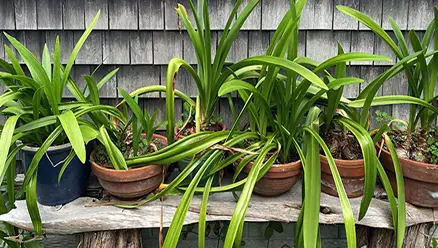
As I have already mentioned, amaryllis can be grown outdoors easily in USDA climate zones 9 through 11.
Amaryllis owners in different zones can only move their potted plants outdoors during the warmer summer months.
This is perfectly acceptable and amaryllis will respond well to being brought outdoors in most areas during the summer as long as temperatures remain in the ranges that I have already outlined.
Why your indoor amaryllis will not bloom when they are brought outside
A common problem that many amaryllis houseplant owners encounter is a lack of blooming of the plant when they take it outside.
A plant that has been blooming consistently year on year may not bloom as expected when it is moved outdoors in summer.
Why do some indoor amaryllis not bloom when you take them outside in the summer?
Potted amaryllis that are grown and kept indoors for most of the year require time to acclimatize when they are brought outside.
Bringing any indoor plant outside may cause a disruption in the normal blooming times of the plant and amaryllis is no different.
You may simply have to wait a little longer to see the first signs of flowering.
Maybe you should consider moving the plant outdoors earlier in the season in the future so your plant has time to acclimatize and blooms when you want it to.
Just be sure that if you move amaryllis outdoors before the summer starts, in spring for example, that night-time temperatures do not plummet below the recommended levels for this plant.
Absolutely never leave amaryllis outside in freezing temperatures or you will lose your plant.
Why garden amaryllis planted in the yard will not bloom
What about non-blooming garden amaryllis that are grown outdoors?
Amaryllis that are grown outdoors, directly in garden soil in the yard, may not bloom for all the same reasons that an indoor potted plant may not bloom.
I will reiterate those reasons again below.
Reasons for a non-blooming outdoor amaryllis:
- Immature bulb.
- Overworked bulb.
- Incorrect soil.
- Insufficient nutrients.
- Incorrect temperatures.
- Not the correct season.
For an explanation of each of these causes for non-blooming amaryllis see the sections above.
If you grow amaryllis outdoors, or want to bring your indoor amaryllis outside in the warmer months, you will require a full care guide.
I therefore advise you to read my article on the proper steps for using amaryllis outside before you take your plant outdoors or plant an amaryllis bulb in the yard.
What to do if your amaryllis doesn’t bloom
If your indoor potted amaryllis, or outdoor potted or garden amaryllis, will not bloom the first step you should take is to ensure the plant is healthy.
Tall leaves that stand straight and that have a lovely natural green color are a sign of a healthy plant, even one that refuses to bloom.
If the leaves are showing any sign of distress then the plant have have bigger problems.
I suggest you search this website for information on the particular leaf problems you are seeing in the plant.
If the leaves are healthy then you can assume the plant is healthy.
Only once you know that the plant is healthy can you then start to take steps to identify the possible causes for a lack of flowering.
Throughout this article I have outlined the potential reasons for a non-blooming amaryllis along with the steps you should take to rectify the situation so your plant can begin flowering again.
Unfortunately, trial and error is sometimes necessary in order to get the cause of a non-blooming plant when the cause is not clearly evident upon first inspection.
Luckily though, amaryllis is an easy-care plant. So it shouldn’t take you very long to identify the cause of the non-blooming in your specific plant now that you are armed with the information I provided in this article.
A simple quick inspection is often all that is required to spot the problem.
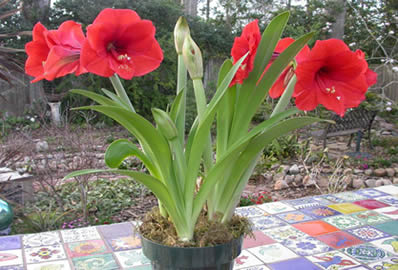
I do advise many amaryllis owners to repot their plant in fresh potting soil when it will not bloom.
This is a great first step to helping the plant bloom and in most cases does the trick, unless of course you are not dealing with a bulb that has been overworked.
If you suspect, or know, that the bulb has been overworked then remove the plant from its current location and put it in a dark, but still warm, place. Allow the bulb 2 – 3 months to recover.
After this period darkness is not needed for dormancy.
If the bulb is growing directly in the yard then you should remove it, gently clean away soil from it and place it into a paper bag.
Put it somewhere that is dark and dry for 2 months before replanting it back in the yard.
How to know your amaryllis is going to bloom
If you have had an amaryllis which has not bloomed you may be wondering how will you know when the plant has finally decided to produce flowers.
How do you know when amaryllis is going to bloom?
You will know that your amaryllis is going to bloom when the plant starts to produce long straight stalks.
Amaryllis is composed mostly of leaves which grow directly from the top of the bulb but flower buds only appear from the stalks. So when you see stalks growing you know the plant will bloom.
As you can see it is fairly easy to identify the reasons for a non-blooming amaryllis and just as easy to fix the situation so the plant flowers year upon year.
I should note here that although I love amaryllis I am reluctant to grow it in my own home simply because I have 5 (rescue) cats.
All types of amaryllis are poisonous and so I do not recommend you keep it if you have curious pets that like to chew on your houseplants or garden foliage.

